Abstract
A set of neurobehavioural tests selected on the basis of information processing theory was used to study the effect of low level occupational lead exposure on 59 lead workers compared with a matched control group of the same number. Only one of the lead exposed group had a blood lead concentration above the current threshold limit value of 3.81 mumol/l at the time of testing (mean 2.36 mumol/l, range 1.19-3.92 mumol/l) and none had been detected above that level in the previous three years. Nevertheless, most neurobehavioural functions tested showed some impairment in the lead workers. Visual sensory function was affected and, perhaps as a consequence, sustained attention and psychomotor tasks were performed more slowly by the lead exposed group. Cognitive functions were also impaired, with sensory store memory, short term memory, and learning abilities all showing deficits in lead workers. Such cognitive deficits may also be partly due to initial degradation of the visual input. Long term memory performance compared equally with control levels possibly because of development of a compensatory strategy such as rehearsal by the lead exposed subjects. Multiple linear regression analysis relating to lead workers test performance and their lead exposure showed that performance on the sensory store memory test alone was significantly related to exposure. This was probably due to the homogeneity of the lead exposed group with regard to blood lead concentrations and the use of blood lead as a measure of chronic lead exposure.
Full text
PDF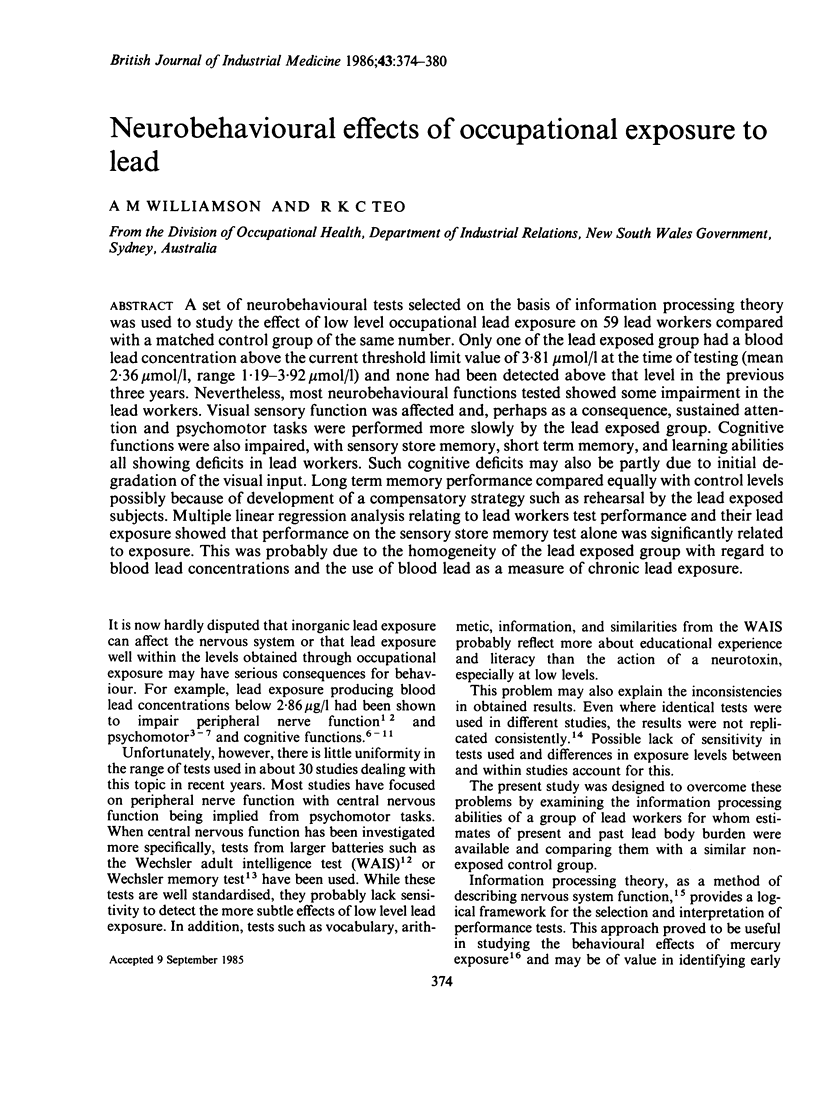
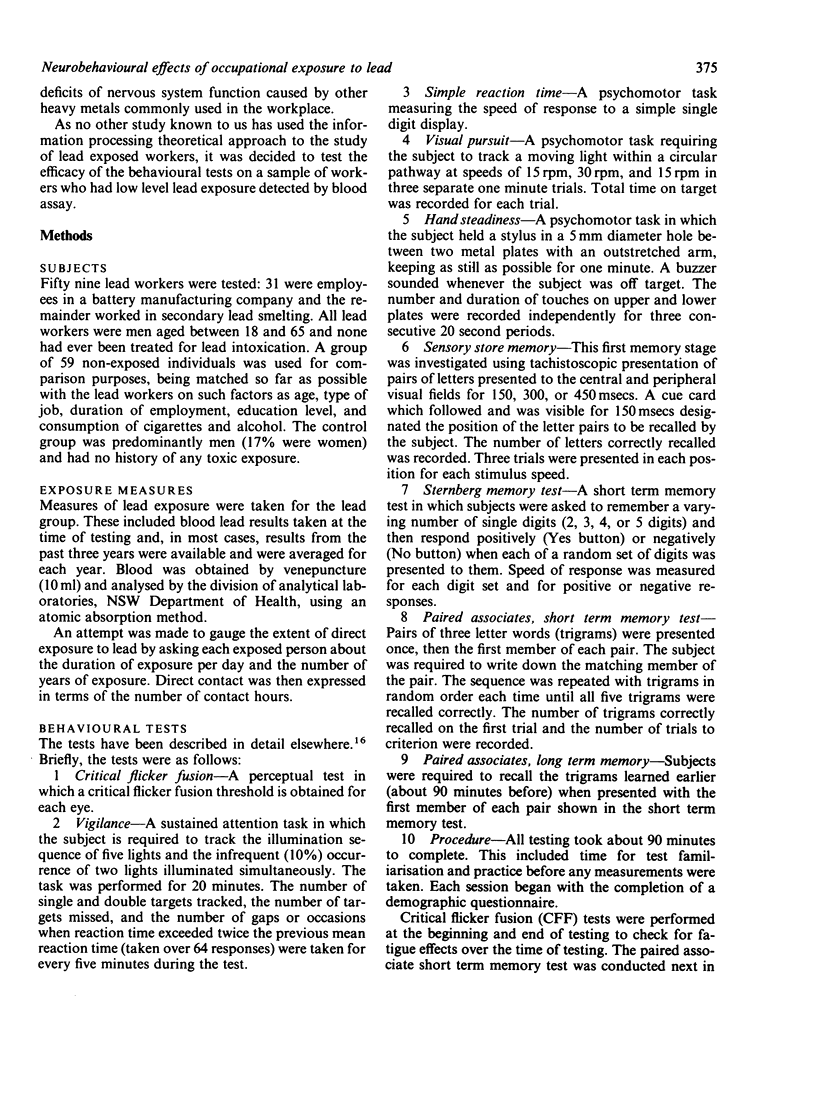
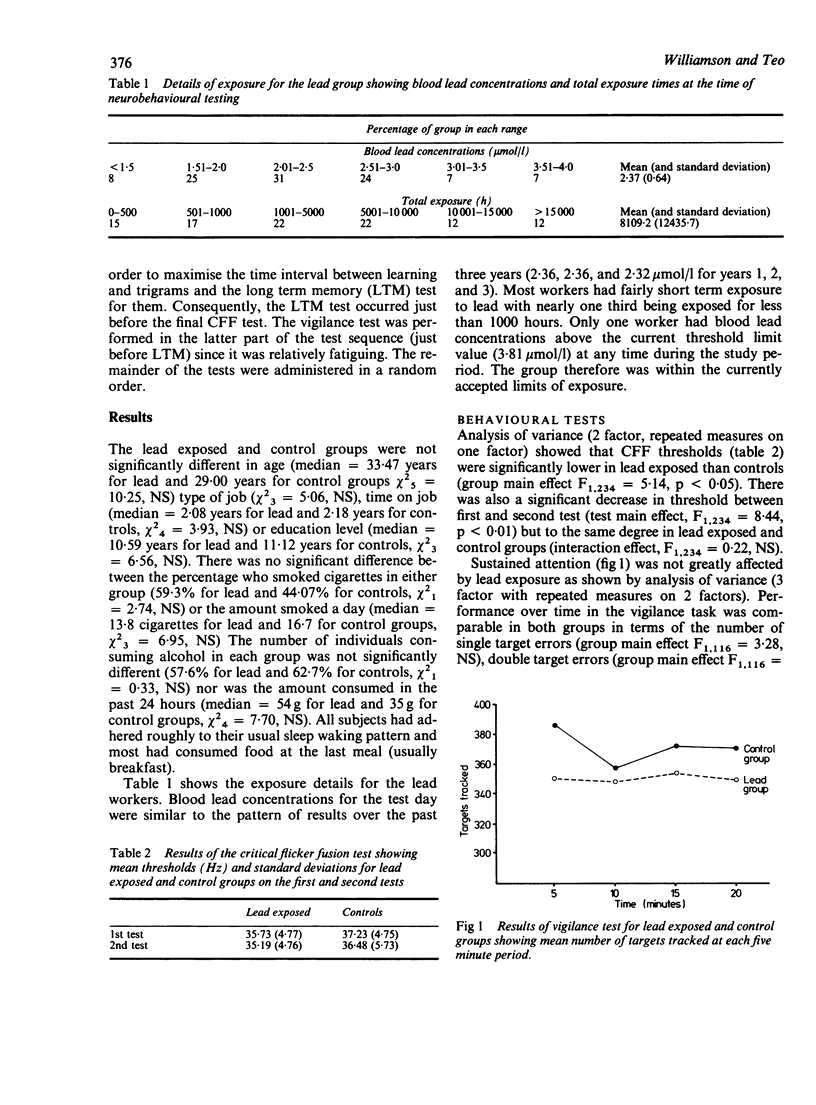
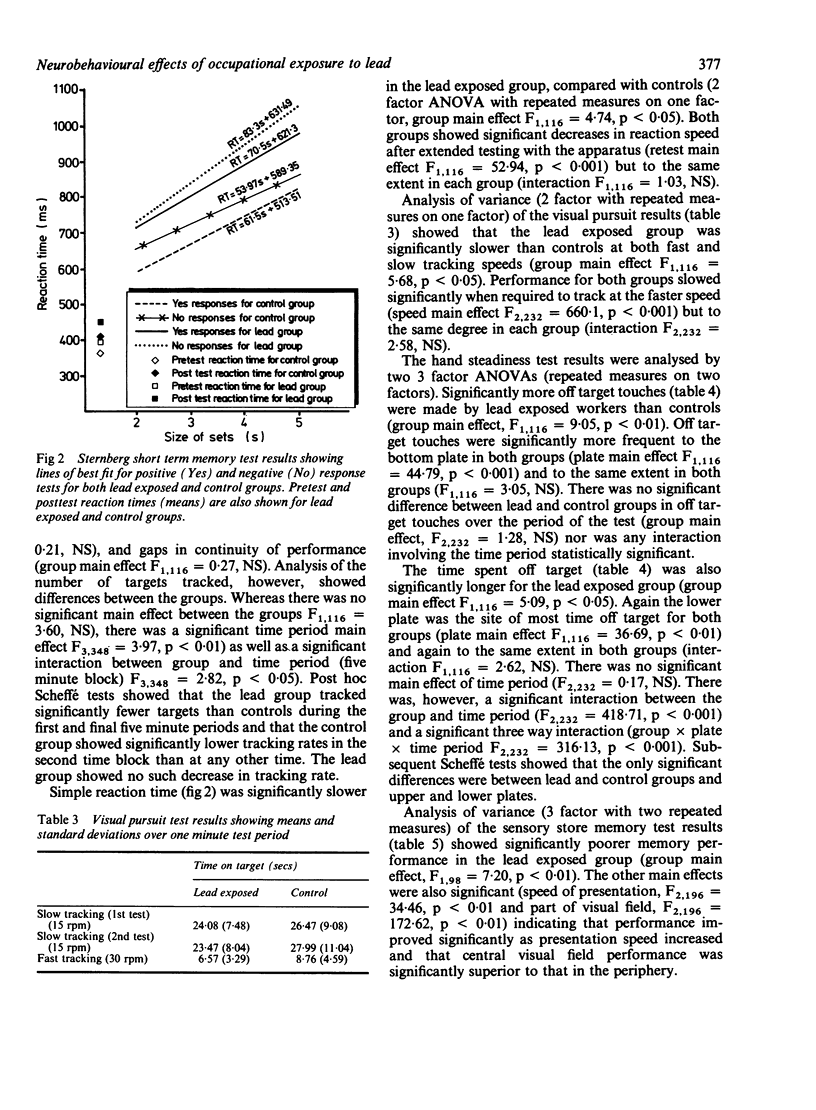
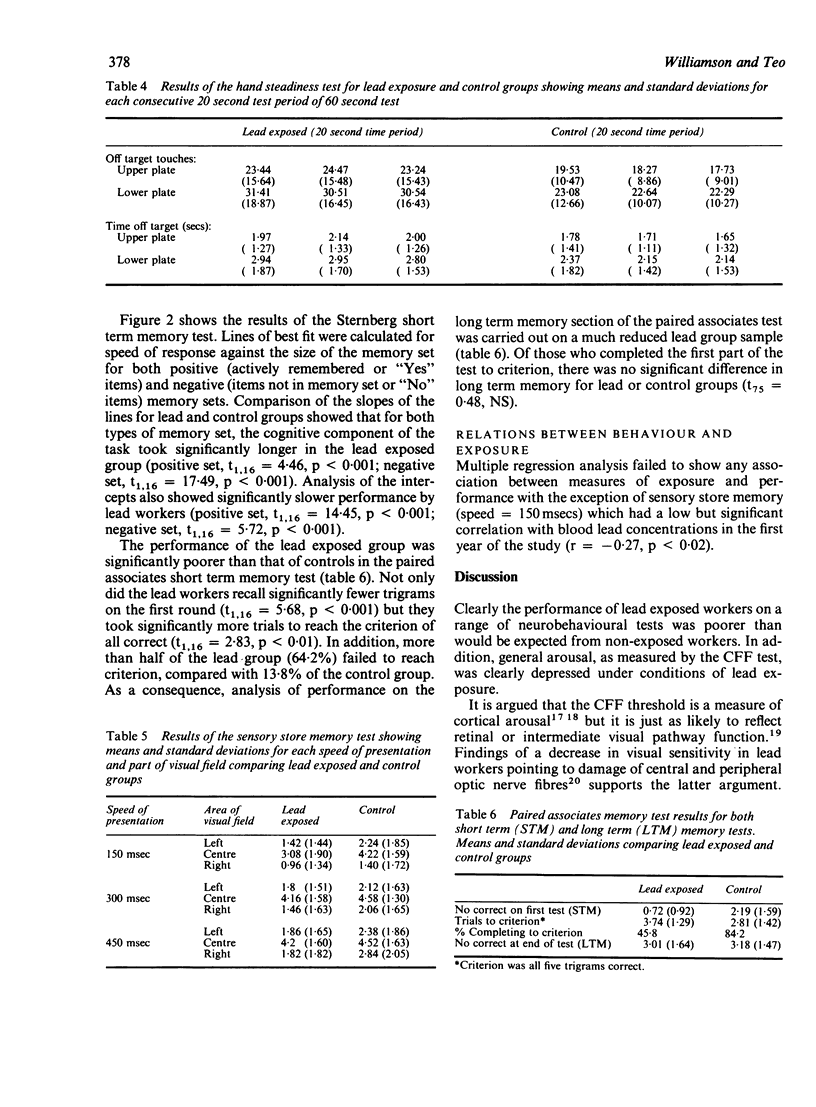
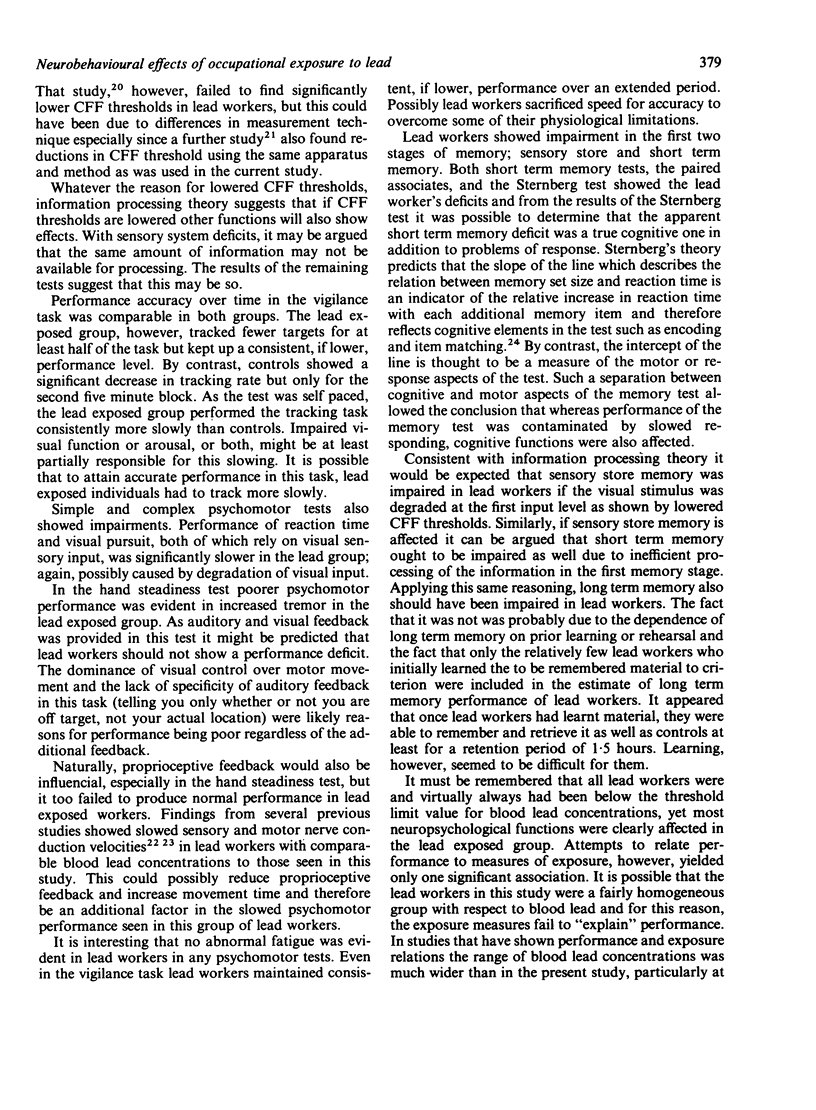
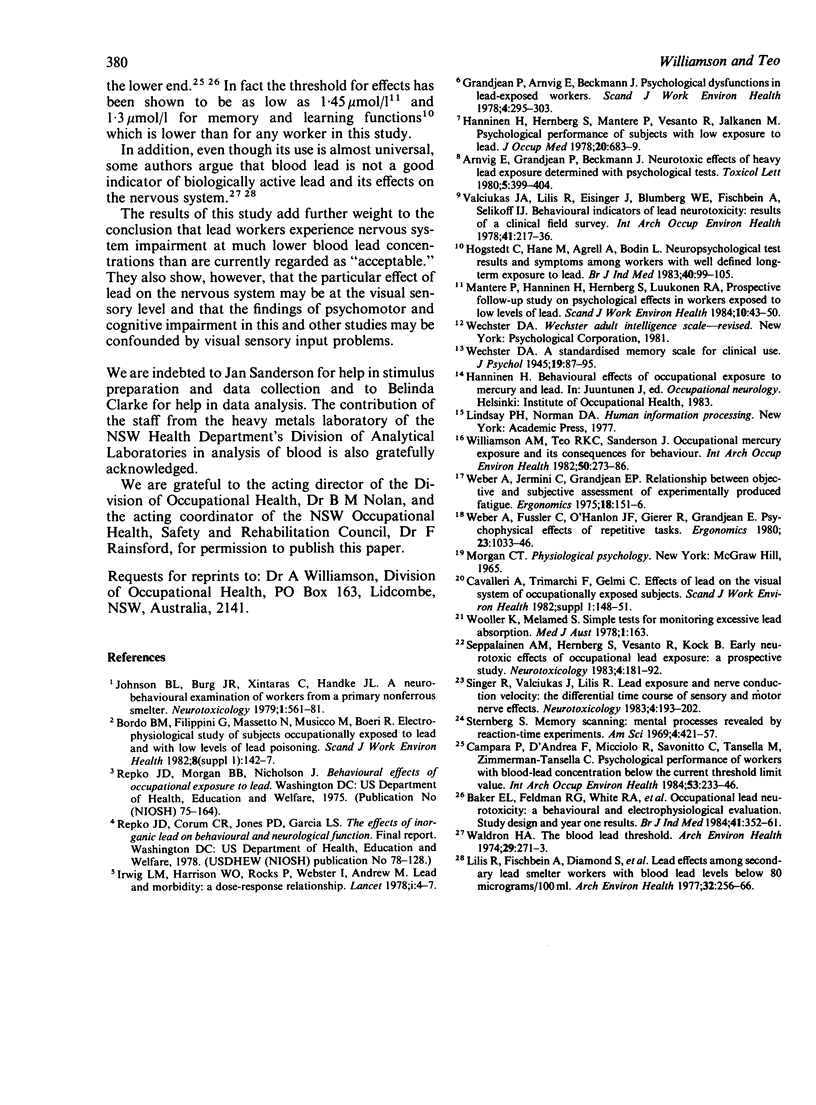
Selected References
These references are in PubMed. This may not be the complete list of references from this article.
- Arnvig E., Grandjean P., Beckmann J. Neurotoxic effects of heavy lead exposure determined with psychological tests. Toxicol Lett. 1980 May;5(6):399–404. doi: 10.1016/0378-4274(80)90022-3. [DOI] [PubMed] [Google Scholar]
- Baker E. L., Feldman R. G., White R. A., Harley J. P., Niles C. A., Dinse G. E., Berkey C. S. Occupational lead neurotoxicity: a behavioural and electrophysiological evaluation. Study design and year one results. Br J Ind Med. 1984 Aug;41(3):352–361. doi: 10.1136/oem.41.3.352. [DOI] [PMC free article] [PubMed] [Google Scholar]
- Bordo B. M., Filippini G., Massetto N., Musicco M., Boeri R. Electrophysiological study of subjects occupationally exposed to lead and with low levels of lead poisoning. Scand J Work Environ Health. 1982;8 (Suppl 1):142–147. [PubMed] [Google Scholar]
- Campara P., D'Andrea F., Micciolo R., Savonitto C., Tansella M., Zimmermann-Tansella C. Psychological performance of workers with blood-lead concentration below the current threshold limit value. Int Arch Occup Environ Health. 1984;53(3):233–246. doi: 10.1007/BF00398816. [DOI] [PubMed] [Google Scholar]
- Cavalleri A., Trimarchi F., Gelmi C., Baruffini A., Minoia C., Biscaldi G., Gallo G. Effects of lead on the visual system of occupationally exposed subjects. Scand J Work Environ Health. 1982;8 (Suppl 1):148–151. [PubMed] [Google Scholar]
- Grandjean P., Arnvig E., Beckmann J. Psychological dysfunctions in lead-exposed workers. Relation to biological parameters of exposure. Scand J Work Environ Health. 1978 Dec;4(4):295–303. doi: 10.5271/sjweh.2696. [DOI] [PubMed] [Google Scholar]
- Haenninen H., Hernberg S., Mantere P., Vesanto R., Jalkanen M. Psychological performance of subjects with low exposure to lead. J Occup Med. 1978 Oct;20(10):683–689. [PubMed] [Google Scholar]
- Hogstedt C., Hane M., Agrell A., Bodin L. Neuropsychological test results and symptoms among workers with well-defined long-term exposure to lead. Br J Ind Med. 1983 Feb;40(1):99–105. doi: 10.1136/oem.40.1.99. [DOI] [PMC free article] [PubMed] [Google Scholar]
- Irwig L. M., Harrison W. O., Rocks P., Webster I., Andrew M. Lead and morbidity: A dose-response relationship. Lancet. 1978 Jul 1;2(8079):4–7. doi: 10.1016/s0140-6736(78)91319-3. [DOI] [PubMed] [Google Scholar]
- Lilis R., Blumberg W. E., Fischbein A., Eisinger J., Diamond S., Anderson H. A., Selikoff I. J. Lead effects among secondary lead smelter workers with blood lead levels below 80 microgram/100 ml. Arch Environ Health. 1977 Nov-Dec;32(6):256–266. doi: 10.1080/00039896.1977.10667292. [DOI] [PubMed] [Google Scholar]
- Mantere P., Hänninen H., Hernberg S., Luukkonen R. A prospective follow-up study on psychological effects in workers exposed to low levels of lead. Scand J Work Environ Health. 1984 Feb;10(1):43–50. doi: 10.5271/sjweh.2364. [DOI] [PubMed] [Google Scholar]
- Seppäläinen A. M., Hernberg S., Vesanto R., Kock B. Early neurotoxic effects of occupational lead exposure: a prospective study. Neurotoxicology. 1983 Summer;4(2):181–192. [PubMed] [Google Scholar]
- Singer R., Valciukas J. A., Lilis R. Lead exposure and nerve conduction velocity: the differential time course of sensory and motor nerve effects. Neurotoxicology. 1983 Summer;4(2):193–202. [PubMed] [Google Scholar]
- Sternberg S. Memory-scanning: mental processes revealed by reaction-time experiments. Am Sci. 1969 Winter;57(4):421–457. [PubMed] [Google Scholar]
- Valciukas J. A., Lilis R., Eisinger J., Blumberg W. E., Fischbein A., Selikoff I. J. Behavioral indicators of lead neurotoxicity: results of a clinical field survey. Int Arch Occup Environ Health. 1978 Jul 14;41(4):217–236. doi: 10.1007/BF00378753. [DOI] [PubMed] [Google Scholar]
- Waldron H. A. The blood lead threshold. Arch Environ Health. 1974 Nov;29(5):271–273. doi: 10.1080/00039896.1974.10666586. [DOI] [PubMed] [Google Scholar]
- Weber A., Fussler C., O'Hanlon J. F., Gierer R., Grandjean E. Psychophysiological effects of repetitive tasks. Ergonomics. 1980 Nov;23(11):1033–1046. doi: 10.1080/00140138008924812. [DOI] [PubMed] [Google Scholar]
- Williamson A. M., Teo R. K., Sanderson J. Occupational mercury exposure and its consequences for behaviour. Int Arch Occup Environ Health. 1982;50(3):273–286. doi: 10.1007/BF00378089. [DOI] [PubMed] [Google Scholar]
- Wooller K., Melamed S. Simple tests for monitoring excessive lead absorption. Med J Aust. 1978 Feb 11;1(3):163–164. doi: 10.5694/j.1326-5377.1978.tb107809.x. [DOI] [PubMed] [Google Scholar]


